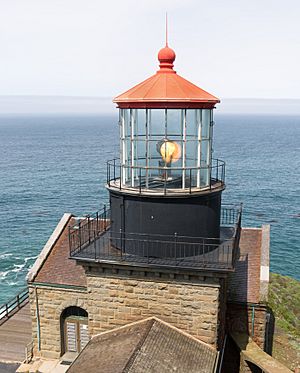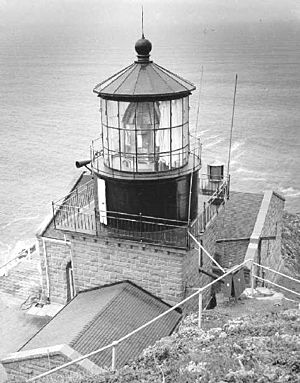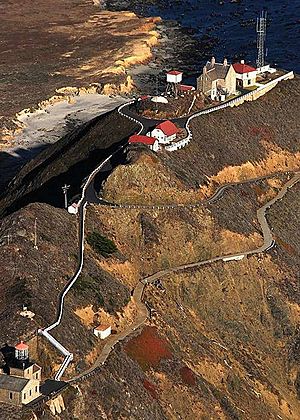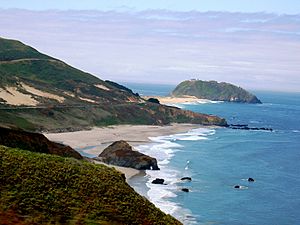Point Sur Lighthouse facts for kids
 |
|
| Point Sur Light in 2013 | |
|
|
|
| Location | Point Sur State Historic Park California United States |
|---|---|
| Coordinates | 36°18′22.79″N 121°54′05.36″W / 36.3063306°N 121.9014889°W |
| Year first constructed | 1889 |
| Automated | 1972 |
| Construction | sandstone tower |
| Tower shape | square tower with balcony and lantern attached to fog signal building |
| Markings / pattern | unpainted tower, black lantern |
| Height | 48 ft (15 m) |
| Focal height | 270 ft (82 m) |
| Original lens | First order Fresnel lens |
| Current lens | DCB-224 |
| Characteristic | Fl W 15s. |
| Fog signal | 2 blasts every 60 |
| Admiralty number | G3988 |
| USCG number | 6-0280 |
The Point Sur Lightstation is a famous lighthouse in California. It stands on a tall rock at Point Sur State Historic Park. This important landmark is about 135 miles south of San Francisco.
The lighthouse was built in 1889. It is 40 feet tall and its light shines from 270 feet above the sea. As of 2016, the light still helps ships navigate safely. Point Sur is special because it is the only complete lighthouse from the early 1900s that you can visit in California. You can take a three-hour walking tour led by volunteers on Wednesdays and weekends.
Contents
Building the Point Sur Lighthouse
The rock where the lighthouse stands was originally over 360 feet high. It was only 10 to 12 feet wide at the top. Workers had to blast away part of the top to make space for the lighthouse.
To move heavy granite and other building materials, a contractor built a 500-foot railway. They also made a special road from wooden planks. To reach the top on foot, there was a long staircase with 395 steps.
How the Light Shines
The lighthouse has used four different light sources over time. First, it had an oil wick lamp, then an oil vapor lamp. These lamps used different fuels like whale oil, lard oil, and kerosene. Electricity did not arrive at the lighthouse until the 1950s.
Point Sur was a very important spot for ships. So, it got a first-order Fresnel lens. This was the largest type of lens made at the time. The lens was more than 6 feet wide and 9 feet tall. It weighed 4,330 pounds! It had 16 panels of special glass prisms. Each panel had a "bulls-eye" in the center. These prisms helped the light beam travel far. The light from Point Sur could be seen up to 23 miles away. This is because the light is 270 feet high.
The entire light structure, including its base and clockwork, was 18 feet tall. It weighed 9,570 pounds. Each part of the lens helped project the light even further.
Loud Foghorns
When there was thick fog, the light beam might not be seen. So, the lighthouse also had a foghorn to warn ships. The first foghorn used coal for power. This system needed a lot of work. It was soon replaced by better technology.
A steam-powered fog signal was installed around 1900. It burned wood from the redwood trees of Big Sur. This steam boiler used about 100 cords of wood each year. From 1935 to 1960, "Diaphone horns" were used. They made a two-tone "bee-oh" sound.
In 1972, the "Super Tyfon Double Fog Signal" was put in place. This system used two compressed air horns. They sounded at the same time and could be heard up to 3 nautical miles away. Today, a modern electric fog signal is used. It is a 12-volt, high-frequency signal. It can be heard up to half a nautical mile away. This high-frequency sound works very well in fog.
Buildings at the Station
The lighthouse had a head keeper and three assistant keepers. Their families lived with them at the station. There was a home for the head keeper's family. Another building housed the assistant keepers.
Life at Point Sur was very isolated. The station had everything the families needed to live there. There was a large tank that held 53,000 gallons of water. Later, a water tower replaced it. A pump house brought water from a well at the base of the rocks.
There was also a barn for horses and cattle. A carpenter and blacksmith shop held supplies. This allowed keepers to do their own repairs and building. The nearby town of Monterey was a full day's trip away. This changed when the Cabrillo-San Simeon Highway was finished in 1937. The lamp tower, oil room, and fog signal room were all in one building. This was because space was limited.
Naming Point Sur
The land formation known as Point Sur can be seen from 10 miles out at sea. It was first written about by Juan Rodríguez Cabrillo in 1552. Sebastian Viscaino visited the area in the early 1600s. His 1603 map called it "Punta que Parece Isla." This means "Point that looks like an island." In 1769, explorer Miguel Costansó named it "Morro de la Trompa." This meant "Rock of the Trumpet" because it looked like a trumpet-shaped rock.
The name "El Sur" (meaning "The South") was first used for a land grant in 1834. This grant was called Rancho El Sur. The rock's name was shortened to Moro Rock. Then, in 1851, the U.S. Coast Survey renamed it Point Sur.
History of the Lighthouse

In 1793, British explorer George Vancouver described Point Sur. He called it a "small, high, rocky lump of land." Point Sur has always been a danger to ships. Many ships crashed there after the California Gold Rush started in 1849. In 1874, the United States Lighthouse Service said Point Sur was a very important place for a lighthouse.
In 1886, Congress set aside $50,000 to build the lighthouse. This money ran out, and construction stopped. Congress then gave another $50,000 in 1887.
Twenty-five men worked to build the lighthouse and other buildings. They built a road to the rock. They blasted a path to the top. They also built a special tramway from the shore to the peak. By the end of the first year, much of the work was done. The lighthouse was finished and its light turned on in August 1889. Life at Point Sur was very lonely. The only road to Monterey was long and often dangerous.
The U.S. Lighthouse Service provided a horse and wagon. This was used to get mail and supplies from Pfeiffer's Resort. Each family had a garden for fresh vegetables. Big supplies like coal, firewood, and food came by a "lighthouse tender" ship. These ships serviced remote lighthouses that could not be reached by land. The ship would anchor and send smaller boats with supplies. These supplies were lifted to a platform at the base of the rock. Then, they were pulled up to the living area by a steam engine.
Point Sur was very self-sufficient. Life became less isolated after Highway 1 was completed in 1937. This highway connected Big Sur with Monterey and San Luis Obispo. Before Highway 1, the coast south of Carmel was very remote.
Two years later, the U.S. Coast Guard took over all navigation aids. Lighthouse Service employees could join the Coast Guard or remain civil service workers.
Today, Point Sur Light Station is a California Historical Landmark. In 1991, the lighthouse and a 37-acre area were added to the U.S. National Register of Historic Places. In 2004, the Coast Guard gave the building and land to the California Department of Parks and Recreation.
The original Fresnel lens was moved in 1978. It became an exhibit at the Allen Knight Maritime Museum of Monterey. Later, the museum no longer wanted the lens. People and groups worked to bring the lens back to Point Sur. The lens is still owned by the United States Coast Guard. They had to approve its return. A group called Central Coast Light Keepers raised over $100,000. This money paid to bring the lens back. The project was approved in late 2017. The lens was taken apart, fixed, and stored. It will be moved back to the lighthouse and put together again.
Shipwrecks Near Point Sur
Many ships have crashed near Point Sur over the years. Here are some notable ones:
- April 20, 1875 – Ventura
- April 22, 1894 – SS Los Angeles
- December 5, 1909 -Majestic
- October 3, 1915 – Catania
- July 21, 1916 – Shna-Yak
- September 23, 1921 – G.C. Lindquer
- September 16, 1922 – Thomas Wand
- March 4, 1923 – Babinda
- April 4, 1930 Panama
- March 30, 1930 – Rhine Maru
- November 25, 1933 – Lupine
- February 13, 1935 – USS Macon (ZRS-5)
In February 1935, a navy airship called the USS Macon (ZRS-5) crashed into the sea. It was about 10 miles from Point Sur. Two of the eighty-three crew members died that day. The crash happened because a fin near the rear of the airship broke. The US Navy had a program for airships and light aircraft. This was to help with scouting for fleet operations. It was meant to give early warnings against enemies. After the crashes of the USS Shenandoah (ZR-1), USS Akron, and Macon, the navy ended this program.
- May 24, 1946 – Frank Lawrence
- October 24, 1947 – Sparrows Point
- May 14, 1956 Howard Olsen
Head Lightkeepers
Here are some of the head lightkeepers who worked at Point Sur:
- James Nightwine (1889–1890)
- John F. Ingersoll (1890–1901)
- Ora O. Newhall (1901–1908)
- John W. Astrom (1908–1927)
- William Mollering (1927–1931)
- Thomas Henderson (1932–1938)
- Charles R. Coursey (1938–1944)
Images for kids





